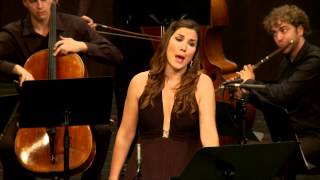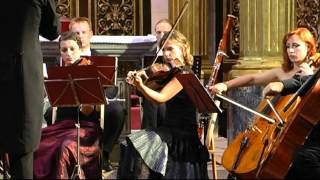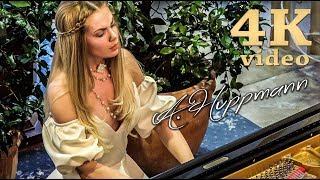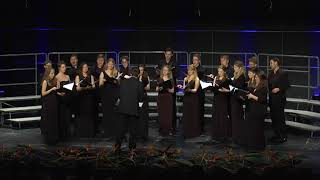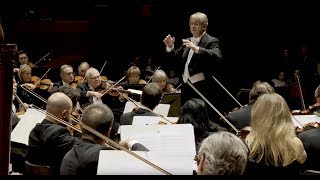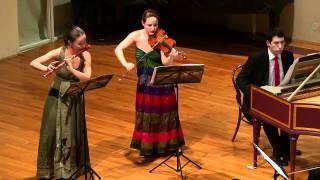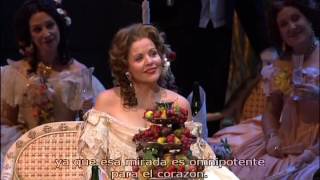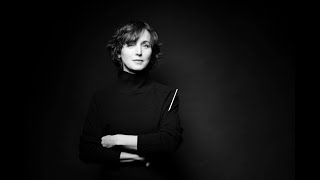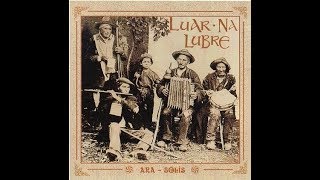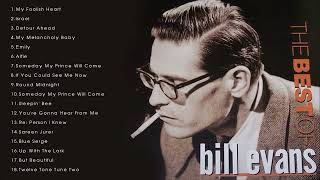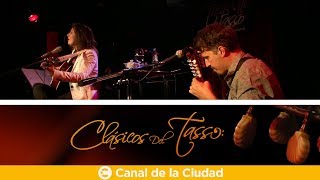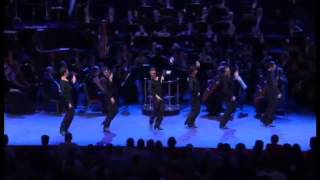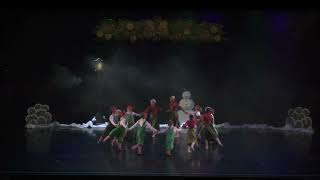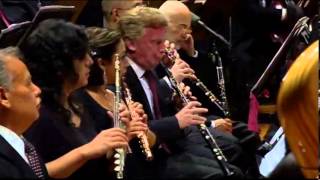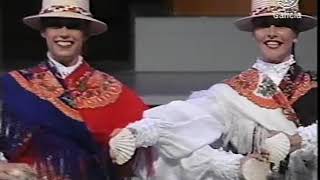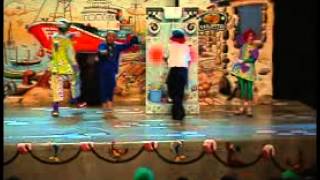On July 25, the National Day of Galiza is celebrated
Recommended music videos for initiation to classical music
Xoán Montes (1840-1899) was a Galician composer, instrumentalist and teacher born in Lugo . In 1850 he began his studies at the Conciliar Seminary of Lugo with the aim of pursuing a priestly career. He would spend fourteen years training as an intern at the ecclesiastical institution, leaving it in the summer of 1864 to dedicate himself entirely to the practice of music. During his years as a seminarian Montes received very little musical training that he himself would need to continue in a self-taught manner studying the texts of Fetis-Gil, Eslava or Berlioz . In Montes ' production we find compositions and arrangements for choir, organ, band, orchestra, quartet, sextet, voice or piano. He died on the night of June 23 to 24, 1899 due to a cerebral hemorrhage.
Negra sombra is a Galician poem by Rosalía de Castro set to music by Xoán Montes and converted by him into one of the most emblematic Galician songs. Today María Eugenia Boix offers it to us accompanied by Natalia Ensemble. Singularly linked to ancient music and the baroque repertoire, soprano María Eugenia Boix also claims to be a soloist very close to the stage, theater and popular music. On the other hand, Natalia Ensemble is an ensemble created in 2013 and made up of 17 performers who, after having joined various orchestras, have wanted to continue making music together.
Tomaso Albinoni (1671-1751) was an Italian Baroque composer, who was born and died in Venice ; known in his time for his operas, when today his popularity comes above all from his famous Adagio , which was not written by him, but rather composed in 1945 by the Italian musicologist Remo Giazotto based on fragments of a sonata for strings and organ. by Albinoni . In contrast to the composers of his time, he never sought a position in the Church or the Court , since he defended himself with his own resources and was tremendously jealous of his own independence. Son of a wealthy family, he studied singing and violin and composed some 50 operas and abundant instrumental music; above all, sonatas for solo and trio and concertos for oboe and violin.
Albinoni's Adagio is a neo-Baroque piece for strings and organ in G minor originally attributed to the Venetian composer Tomaso Albinoni , but was actually composed in 1945 by the Italian musicologist Remo Giazotto . Published for the first time in 1958 by the Casa Ricordi publishing house, the publisher launched as a sales pitch that the author had based himself on some fragments of a slow movement of a trio sonata by Albinoni presumably found in the ruins of the Dresden Library after the bombings of the city during World War II , but no serious proof of the existence of such fragments has ever been found. On the contrary, the Staatsbibliothek Dresden has formally denied having them in its sheet music collection.
Frédéric Chopin (1810-1849) was a Polish virtuoso pianist and composer; As a pianist, he is considered one of the most important in history and as a composer, one of the leaders of Romanticism . He was born into a vocationally musical family; His mother played the piano and his father played the violin and flute; His first teacher was a sister of his with whom he liked to play four-hand pieces. At the age of eight he gave his first public concert at the Radziwill family palace in Warsaw . Chopin 's work focuses exclusively on the piano, solo or concertante, with which he undertook a solo career of technical perfection, expressive splendor and deepening of rubato until he became the musical reference for said instrument.
Catalog of XXX's works . His works are classified by their Opus number ( from the Latin opus 'work'; op. abbreviation) which is a term used in music to catalog the works of most composers since the 17th century .
The Polonaise is a national dance and musical form originating in Poland ; hence its name. Formally it consists of a moderate march movement and ternary rhythm (3/4), with a characteristic beginning in thetic rhythm (the melody begins on the first beat of the first measure) and ending in prosthesis (the last accented note of the last phrase has a or more notes added); rhythm reminiscent of bolero . Some of the most notable and famous polonaises are those of Frédéric Chopin , such as No. 1 that we offer today in interpretation by the Russian pianist Anastasia Huppmann .
Eduardo Mokoroa (1867-1959). He was an organist, conductor and composer from Guipuzcoa, born in Tolosa . He studied organ, harmony, counterpoint and fugue with Modesto Letamendía and Felipe Gorriti . He was director of the Orfeón and the Municipal Band of his hometown. The first group won numerous prizes in mass choral competitions competing with choirs as valuable as the Pamplonés and the Donostiarra , directed by Remigio Múgica and Secundino Esnaola . He taught and formed a true school of organists, conductors and composers. The Tolosa City Council , in 1942, named Mocoroa Favorite Son of the Town; The Donostiarra Orfeón and the "Felipe Gorriti" Escolanía appointed him Honorary Director, and in 1943 he was awarded the Cross of Alfonso X the Wise.
Sansara is a young English choir, innovative in its way of understanding choral music. It covers the most varied styles, it does not have its own director, it does not rehearse regularly but on special occasions, and it always tries to combine tradition and avant-garde. It comes from Cambridge , but is made up of singers from different areas of England . Its members meet for several days in London when a concert has to be prepared. It is a dynamic and enthusiastic group, which insists on exploring new and even unorthodox paths in music. It is the choralists themselves who direct the choir according to the pieces of the repertoire that they choose to perform, taking into account the specialty and particular musical interest of each of the members of the group.
Recommended classical music videos
Andrés Gaos Berea (La Coruña 1874 - Mar del Plata 1959) was a Galician musical pedagogue, composer and violinist. He studied with the violinist Eduardo Dorado and upon finishing his primary studies, the Provincial Council of A Coruña gave him a pension to study violin in Madrid and Brussels . In the summer of 1895 he arrived in Buenos Aires where he met his future wife, the singer and violinist América Montenegro , with whom he had five children. Divorced in 1917, he married his student Luisa Guillochon with whom he had three more children, and after eight years in France , he returned permanently to Buenos Aires as a state education inspector. His compositional work was mainly oriented towards various genres of popular music (songs, dances, works for institutional competitions), chamber, theatrical and symphonic music.
Nocturnal Impression was composed in a month and premiered at the Sala Gaveau in Paris on September 20, 1937, with Gaos himself conducting the Lamoreux Orchestra . The work passed without pain or glory, until in 1987 Joam Trillo dusted off the score for the inaugural concert of the Xoven Orquestra de Galicia ; Trillo fell in love with the smell of the sea and seagulls that the work exhales, and he did not stop until he obtained a subsidy from the Xunta to print the score, sending a copy to the best-known Spanish and Argentine orchestras; He managed to get other conductors to make room for it in their repertoire and for the Night Impression to rub shoulders with favorite pieces for string orchestra by Bach, Haydn, Brahms and Tchaikovsky on some CDs released by the BMG label. ( Extracted from the article by Emilio Fernández)
Today it is offered to us by the Galician Symphony conducted by the Burgos maestro Víctor Pablo Pérez.
Johann Sebastian Bach (1685-1750) was a German violinist, organist, conductor and composer; He was born in Eisenach into the most prominent musical family in history with more than 30 famous composers within it. In 1703 he obtained his first job as a court musician for the Prince of Arndstat and in 1707 he moved to Mülhausen as an organist, where he married his cousin Maria Barbara with whom he had seven children. After the death of his wife in 1720, he remarried after a year and a half to María Magdalena with whom he would have another thirteen children. In 1723 he moved to Leipzig where he would reside until his death at the age of 65. A prolific composer, he is considered one of the main three geniuses in the History of Music along with Mozart and Beethoven.
The catalog of Bach's works or Bach-Werke-Verzeichnis , better known by its acronym BWV , consists of a numbered index of all the composer's works arranged thematically by type of work, genres and according to their vocal or instrumental nature and used by academics and musicians from around the world. This catalog was created in 1950 by the German musicologist Wolfgang Schmieder .
The Brandenburg Concerto No. 5, BWV1050 is part of an album of six concertos for different instruments written during his stay in Köthen and called the Brandenburg Concertos . The No. 5 that we present today is a Concerto Grosso (a small group of soloists performs in front of a larger accompaniment group). In the present case, the group of soloists is represented by the violin, the flute and the harpsichord, which plays the double role of soloist at times and accompanist at other times. The concert is articulated in three movements: I (0´06´´) ALLEGRO .-. II (10´23´´) AFFETTUOSO .-. III (16´15´´) ALLEGRO.
The performance is performed by the Croatian Baroque Ensemble , a musical ensemble specialized in the historicist interpretation of baroque music and a regular guest at the most relevant international festivals of this genre.
Giuseppe Verdi (1813-1901) was an Italian composer; He wrote 28 operas considered a bridge from bel canto to verismo. He was born in Le Roncole near Busetto ; As a child he belonged to the Church choir where he received organ lessons and at the age of ten his parents enrolled him in the Busetto Music School , where he received the unconditional support of the patron Antonio Berezzi . Supported by Berezzi , at the age of 19 he moved to Milan where he continued his studies, after which he returned to Busetto as a music teacher and where he married Berezzi 's daughter. In his youth he sympathized with the popular movements that demanded the unity of an Italy divided by different European dynasties. To the point that they chanted “Viva Verdi” with the double meaning of Viva V ittorio E manuele R e D ' I talia.
La Traviata (original title in Italian, which in Spanish could be translated as the lost one or better the misguided one) is an opera in three acts with music by Giuseppe Verdi and a libretto in Italian by Francesco Maria Piave , based on the novel by Alexandre Dumas (son ) The Lady of the Camellias (1852). Premiered on March 6, 1853 at the La Fenice Theater in Venice , it forms, together with Rigoletto and The Troubadour , the popular operatic trilogy that Verdi composed in the middle of his career. Initially titled Violetta - the name of the main character - it is apparently based on the life of a Parisian courtesan, Alphonsine Plessis . Piave and Verdi wanted to follow Dumas by giving the opera a contemporary setting, but the La Fenice authorities insisted that it be set in the past, "around 1700." It was not until the 1880s that the original wishes of the composer and librettist were respected and "realistic" productions were performed.
Today's main speakers : Violetta Valery – Renée Fleming , Alfredo Germont – Rolando Villazón , Giorgio Germont – Renato Bruson , Master Director – James Conlon
Igor Stravinsky (1882-1971) was a Russian pianist, conductor and composer; For many critics, the most important of the 20th century . In his long life he delved into different musical styles and genres from post-romanticism to serialism or jazz . He studied, among others, with Rimski Korsakov and worked for different genres and musical groups; but after meeting Sergei Diaghilev , founder of the Ballets Russes , he collaborated closely with him. Stravinsky also wrote for various types of ensembles and genres from operas and symphonies to small piano pieces and works for jazz groups, achieving great fame not only as a composer, but also as a pianist and conductor. Time magazine considered him one of the most influential personalities of the 20th century .
The Symphony in Three Movements is a work by Igor Stravinsky , who wrote it from 1942 to 1945 commissioned by the New York Philharmonic Symphony Society ; It was premiered by the New York Philharmonic Orchestra conducted by Stravinsky himself on January 24, 1946. The Symphony in Three Movements is considered Stravinsky 's first major composition after emigrating to the United States ; In it he uses material previously written for aborted film projects.
Structure. The Symphony is articulated in three movements: The FIRST MOVEMENT (0´23´´) Overture: Allegro was inspired by a documentary about Japanese scorched earth tactics in China . The presence of the piano comes from a piano concerto that was left incomplete. In the SECOND MOVEMENT (10´27´´) Andante; Interlude: L'istesso tempo music for harp is prominent with the use of themes he had written for the film adaptation The Song of Bernadette . The THIRD MOVEMENT (16'24'') With a motorcycle deals with images of German soldiers taking steps back in the face of the growing success of the Allied forces; To do this, it uses reorganized material from previous abandoned projects, while uniting the first two movements giving equal emphasis to the piano and the harp.
Today it is offered to us by the Victoria Symphony conducted by Canadian maestro Tania Miller .
Recommended music videos for all tastes
Luar na lubre is a Galician folk music group. (Luar na lubre means Moonlight in the sacred forest of the Celts) born in 1986 in the city of A Coruña and part of the current that has come to be called " Celtic music" . Throughout their career as a musical group they have spread and valued Galician culture and music, taking it to remote places around the world. In 1999 Mike Oldfield proposed to collaborate on his world tour (Live then & Now'99), and in this way they gained international fame. Luar na lubre highlights Galician culture with traditional themes from the area, although they are not left out of the Celtic influences of countries with similar musical traditions, such as Ireland, Scotland or Brittany . This group also has social awareness and commitment to current events.
Bill Evans (1929-1980), was an American jazz pianist and composer. His work encompasses cool, post-bop and modal music . He is considered one of the most important jazz pianists in history for his impressionistic use of harmony, his interpretations of traditional jazz repertoire, his adoption of the block chord style, and his characteristic rhythmically independent melodic lines. His influence is can be seen in numerous well-known pianists, such as Brad Mehldau, Chick Corea, Keith Jarrett and Herbie Hancock . Many of Evans ' compositions, such as " Waltz for Debby" and "Time Remembered" have become jazz standards, played and recorded by countless artists. Evans received 31 Grammy Award nominations and 7 awards, and was inducted into the DownBeat Jazz Hall of Fame .
Malena Muyala (1971) Uruguayan singer and composer of tango, waltzes, milongas and milongones. At the young age of 11 he entered the Macció Theater in San José where, under the direction of director Eduardo Malet, he received his first dramatic art classes and performed the works " Percanta que me amurraste " and " Vámonos ". In 1991 he participated in the First National Tango Competition held in Uruguay and won First Prize among 350 participants from all over the country. In 2008 she was invited by the Montevideo Philharmonic Orchestra to perform a show called Malena Muyala + La Filarmónica . Currently she is one of the main female voices in Uruguay and director of the Teatro Solís in Montevideo .
Christina Aguilera (1980) is an American singer, songwriter, actress, model, fashion designer, producer and businesswoman. She began acting and singing at a young age, through roles in theater productions and television shows, including Star Search and Mickey Mouse Club . Aguilera 's work has won numerous awards, including six Grammy Awards and a Latin Grammy . In her songs she includes topics such as love, her childhood, self-esteem, sexuality, feminism and the empowerment of women. She also has a wide vocal range of 4 octaves, being known as "the voice of the generation." . She was the biggest seller of the 2000s for material singles, along with Madonna .
Recommended peculiar videos
Maurice Ravel (1875-1937), born in Ziburu ( Ciboure , Basque Country in France), inherited his meticulous work from his father, an engineer of Swiss origin, and his passion for music from his mother, born in Mendata (Bizkaia). with the folk songs with which he adorned his childhood. A few months after he was born, the family moved to Paris , where at the age of six he began his piano studies. At the age of 14 he entered the Paris Conservatory where he had the opportunity to study with Gabriel Fauré . His first works already show us a strong personality and an independent spirit. In 1928 he toured Canada and the USA where he experienced the jazz that he liked so much and contacted Gershwin . Upon his return to Paris he composed the work that would bring him the most fame, the Bolero, the work that we offer today.
Bolero is a musical work created by Ravel in 1928. The immediate success and rapid universal diffusion of Le Boléro , dedicated to the dancer Ida Rubinstein , made it not only one of the composer's most famous works, but also one of the exponents of 20th century music. An orchestral movement inspired by a Spanish dance, it is characterized by an invariable rhythm and tempo, with an obsessive melody — an ostinato — in C major, repeated over and over again without any modification except the orchestral effects, in a crescendo that, in extremis , ends with a modulation to E major and a thunderous coda.
Today we will be able to watch it with the BBC Philharmonic under the orders of the Álava maestro Juanjo Mena, choreographed by the Antonio Márquez Company .
Giacomo Meyerbeer (1791-1864) was a German composer favored by Parisian audiences for composing operas in the Grand Opéra style. He was a child prodigy and is considered the creator of romantic musical melodrama , usually based on a historical theme and grandiloquently staged, with theatrical effects that dazzled his contemporaries, from floods to fires. It is the latest variant of serious opera: the vast historical opera known as Grand Opera . Between 1836 and the end of the century, he was considered the most important composer in European musical life, with astronomical numbers of performances. He died in Paris while working on his last great opera, La Africana , which would become one of the greatest successes in opera history.
Les Patineurs (The Skaters) is a ballet choreographed by Frederick Ashton with music composed by Giacomo Meyerbeer . The ballet, in one act, depicts a Victorian skating party taking place on a frozen pond on a winter's night where a happy group of young couples dance together with a lone young man until the snow begins to fall and the lone young man Finally he is left alone, spinning like a top in the middle of the pond.
"Fiesta de Tlacotalpan" choreographic painting performed by the Folkloric Ballet of Mexico of Amalia Hernández accompanied by the Youth Symphony Orchestra of the State of Veracruz (Antonio Tornero, concert director) within the 60th Anniversary Gala at the National Auditorium in Mexico City , January 13, 2013. (Comment at the bottom of the video)
The Amalia Hernández Ballet or Folkloric Ballet of Mexico founded in 1952 by the dancer and choreographer Amalia Hernández ; ballet that has been a benchmark of traditional Mexican music and dance for all these years. His performances run throughout the country, while he has traveled to more than 60 countries.
Amalia Hernández (1917-2000) was a Mexican dancer and choreographer, founder, in 1952, of the ballet that bears her name and which is emblematic of the folk art of this country, based in the Palace of Fine Arts in Mexico City. Amalia dedicated herself to rescuing traditional Mexican dances that had been lost over time, striving to improve their quality. In 1959, President López Mateos asked this group to become one of Mexico 's natural ambassadors.
José Manuel Rey de Viana , born in Ourense in 1923 and died in A Coruña in 1995, was a Galician dancer and choreographer. He began dancing at the age of eight; He traveled through various European dance schools. In 1949, together with his wife, also a dancer, he founded the Ballet Gallego Rey de Viana with the aim of making Galician folklore known. His first performance was in A Coruña in 1955. In 1964 he performed in the Spanish pavilion at the World's Fair in New York . In 1971 the direction of the Ballet was transferred to the Provincial Council of A Coruña. At the age of 65 he had to retire at the request of the Provincial Council , carrying out a hunger strike and an artistic demonstration in the Méndez Núñez gardens. The Ballet remained under the direction of the Council .
Recommended music videos for children
Various Wikipedia articles have been used to write these texts.
The texts of Videomusicalis are written in Basque, Spanish and English.





